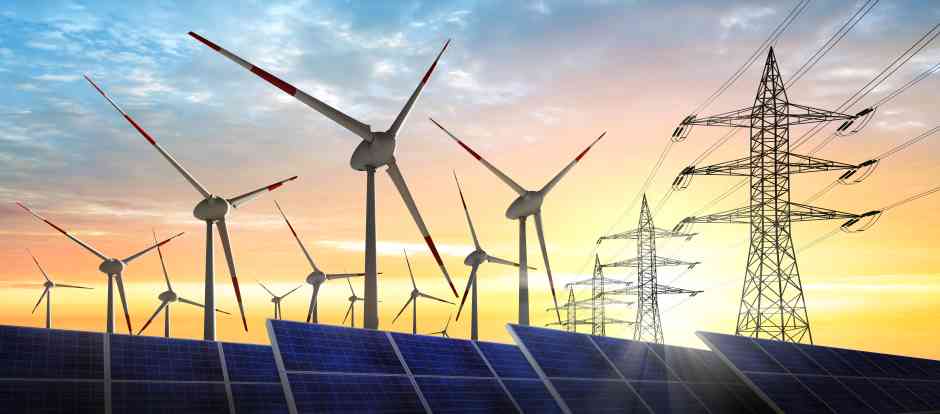
Meet the experts
Andrew Lever - Director, the Carbon Trust, an independent partner to global organisations seeking to move toward a more sustainable future
Dr Tim Stone CBA - Chairman of the Nuclear Industry Association (NIA), the trade association for the civil nuclear industry in the UK.
Prof Jim Watson, Director, UK Energy Research Centre, which conducts interdisciplinary research into sustainable future energy systems
Richard Kirkman, Chief Technology and Innovation Officer, Veolia UK and Ireland, a provider of waste, water and energy management services
Edmund Reid, Head of Strategy for Centrica Business Solutions, a global provider provide energy expertise and distributed energy solutions
In what ways are net zero ambitions compatible with the demands of large electricity users?
AL: Dramatic growth in renewable electricity supply over the last decade means that net zero ambitions are in reach for large electricity users. The majority of greenhouse gas emissions from electricity consumption can be eliminated by switching from fossil fuel-derived to renewable sources of electricity.

TS: Most large electricity users see the need to support the reduction of emissions to tackle climate change, but cost is a very real business issue. Fossil fuels have historically been cheaper and we have to work hard to bring down costs of replacement low and zero carbon power, as well as developing smarter systems to help big electricity customers manage their demand. Cost reductions are already happening with renewables and we know we can also bring down the costs of nuclear power dramatically.
National grid confirms first week of coal-free electricity since 1882
National grid hails greenest summer ever
JW: According to the CCC (Committee on Climate Change), electricity decarbonisation needs to be largely achieved by 2030. Clearly, it will be easier to accommodate the demand of large users of electricity if they maximise investment in energy efficiency. So it isn’t just a case of shifting to low or zero carbon generation, but also a case of improving energy efficiency across the economy.
RK: Large users can cut their energy use in many ways and maintain their operations, while moving towards a net zero goal. Whether it's by energy efficiency, using technologies such as combined heat and power, or new energy sources such as biomass, biogas, solar and wind, they can meet carbon reduction targets. It depends on the business but there is always a way to cut carbon and we have to find the economic answer that also saves costs. There are many proven technologies that make good commercial sense and deliver the energy security essential to industry.
ER: In many ways, large energy users are better placed to reach net zero in energy terms than smaller businesses. Practically speaking, large energy users tend to have dedicated resource in-house, such as an energy manager, and dedicated budget for implementing energy saving measures. They also are more likely to own their premises making infrastructure changes much more straightforward. Many will have internal corporate objectives and shareholder pressure to reduce emissions. For some, they will also be subject to the EU emissions trading scheme, which provides additional cost incentive for reducing emissions.
Which nascent technologies should government be backing in order to help reach – and maintain - net-zero?
AL: In addition to a large-scale move to renewables and ultra-low emission vehicles, reaching net zero will require of greenhouse gas removal options including large-scale forestation, biochar, BECCS (bioenergy with carbon capture and storage), DACCS (direct air capture and carbon storage). Other areas to consider include the use of ammonia for refrigeration purposes. The decarbonisation of heat will require a range of technology solutions including district heating, heat pumps and hydrogen. Whilst many of these technologies are technically mature, further innovation can allow for the full decarbonisation of heat.

TS: A balance needs to be struck, between pushing for breakthroughs in technology, while investing in modern technology that we know works, today. Several smaller nuclear reactor designs are developing well, and the UK leads the world in the development of fusion. Progress is also being made in battery storage and dealing with waste CO2, but we need to make big decisions now on commercially available, proven technology or we will miss the mark.
To have any chance of achieving net zero, we need to be building all the proven low-carbon generation we can, as fast as possible.
JW: Whilst breakthroughs with new technologies might be made in time to meet the 2050 target, this target can be achieved using known technologies. Many of these are already commercially available - or well on their way. So for electricity, the priority should be to continue and expand the deployment incentives for low cost technologies - particularly renewables such as wind & solar - as well as the technologies and infrastructures that will help to balance the electricity system (storage, demand side response, interconnections, and flexible zero carbon generation).
RK: We think government can remain technology neutral and just incentivise the carbon reduction, that way the costs will be minimised and we can develop and deliver the best technical solutions that make carbon and business sense. Solar, wind, biomass, CHP, heat pipes in the ground, heat pumps, batteries are likely to remain important for the next 10 years pending development of new technologies. Waiting for the next technology to emerge simply means more carbon is released to the environment - and the planet can't afford delay.
ER: Flexibility is the key to meeting net zero in energy. Renewables are a necessity in decarbonising our energy, but they are inherently variable. The question is, how are these gaps in generation filled? At present much of this is by burning fossil fuels. We see a future where homes, small businesses and our large energy users are connected as a virtual power plant and are able to make electricity generated by onsite renewables and stored locally, available to the grid. We’ve asked the government to commit to leading on the delivery of fully functioning flexibility markets by 2023 in order to support renewables and meet net zero targets.

Decentralisation is often cited as a way of reducing emissions from energy, but how realistic is this aim across the UK?
AL: Decentralisation is a necessary part of emissions reduction. We will see a convergence of the electricity, heat and transport sectors, which will result in a more holistic approach to providing solutions. As focus shifts to the decarbonisation of the heat and transport sectors, it becomes evident that many of the decarbonisation solutions are linked to the electricity sector. Electrification of transport is an obvious example. For heat, this could include electrification, bioenergy and hydrogen technologies. To achieve this holistic approach, planning and optimisation of local infrastructure is a key requirement.
TS: While we are seeing larger numbers of smaller ‘community’ energy projects, we will still need a centralised grid network to support and transport the doubling of electricity production. Decentralisation simply isn’t compatible with our projected reliance on interconnected systems. For example, electric vehicle-to-grid schemes will only work if there’s a centralised grid to sell your electricity back to. These issues are part of the requirements for the redesigned energy system.
JW: The UK has traditionally had a centralised electricity system - with centralised policies, institutions and governance as well as technologies. I think it would be difficult to achieve a very significant shift towards decentralisation of electricity unless governance, policy, funding and powers are also decentralised further than they are now. Even if this were achieved, there would still be an argument for some centralised infrastructure to balance supply and demand across different locations and regions.

RK: Very realistic. For example, Veolia is the UKs largest decentralised energy provider with around 400 energy production sites and 4TWh (enough for a million homes) under our umbrella. Over many years these have proven the concept of decentralisation and realised major carbon savings across a wide range of sectors including industry...and the water industry. So, we know it works and supports the energy needs of our customers - it just takes vision and commitment from organisations to take a step forward in how they view their energy supply.
ER: The existing energy network was designed for a world of energy flowing from large power stations to passive customers. As we transition to a world with significant renewable deployment and increasingly complex energy flows, so the traditional networks are likely to face new challenges. The future energy system is likely to be one where energy is generated closer to the point of demand. Larger energy users – such as manufacturers – can take control of their energy and turn it into an opportunity to reduce costs and carbon intensity whilst increasing energy resilience.
What grid-level changes will need to take place to accommodate increasing amounts of electricity generated by renewables?
AL: We are already experiencing innovation in the electricity grid to accommodate increasing amounts of renewable generation. One key trend is the emergence of flexible markets, where Distribution Network Operators contract for flexible demand to manage increasing variability from renewable generation. This potentially negates the need to reinforce the network in some areas and allows the grid to be utilised more efficiently. As decarbonisation of the heat and transport sectors continues, greater convergence of grid planning and local infrastructure planning will be required.

TS: In redesigning the energy system, the changes to the grid will be an output from that design. What is clear already, though, is that the resulting design is highly likely to have balanced mix of renewable and baseload or firm power. Managing the overall system so that there is a high degree of resilience at a sensible cost will require the grid to be properly supported both in terms of its own redundancy (which is arguably too little at the moment) but also in terms of the basis on which supply and demand are allowed to connect to it.
JW: There will need to be some further investment in high voltage grid infrastructure, to enable the further expansion of offshore wind. But the main changes are about investment in technologies, infrastructures and other measures to help balance the system - this means more interconnection with other countries, more storage (though battery storage can only help to balance supply and demand over relatively short timescales so far), demand side response (which is already common in industry) and flexible generation (which needs to be zero carbon - so powered by hydrogen, for example, rather than natural gas).
RK: We will need to invest in the grid infrastructure, particularly to facilitate increasing demand from electric vehicle charging, and that's why we should avoid electric heating and look for solutions using waste or recovered heat. We are already helping the grid by encouraging large energy users to either increase demand or reduce generation at times of high renewable output and low national demand. By taking measures such as this, and battery storage, we can ensure supply is stable, makes use of intermittent renewable sources, and gains from a balanced grid that meets the needs of the UK's energy users.




Project to investigate hybrid approach to titanium manufacturing
What is this a hybrid of? Superplastic forming tends to be performed slowly as otherwise the behaviour is the hot creep that typifies hot...